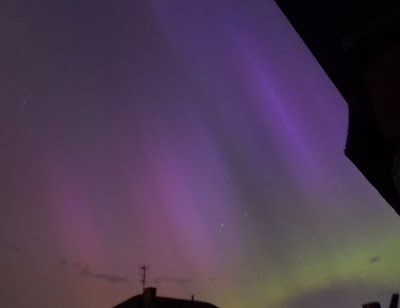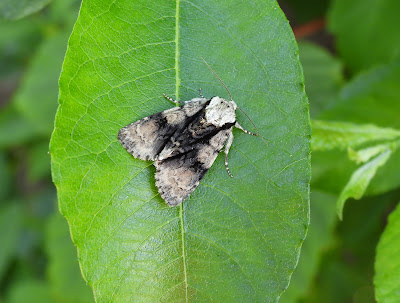It has been two weeks since I last posted, and I apologise for that, but I have been very busy with more breeding birds. This means lots of time in the field, early starts, and not a great deal of time to sit in front of a computer writing my blog!
Over two weeks ago now, Gail and I were back at our BBS site near Poulton-Le-Fylde, and we were carrying out an evening survey as part of the new bird survey guidelines that were introduced last year. We didn't record anything particularly unusual, and if I was to pick out some highlights from the 23 species that we recorded, these would be three Song Thrushes, three Chiffchaffs and a Blackcap, and that would be it.
Three days later, I was back at my clients' farm near Slaidburn, carrying out the second breeding wader survey with a couple of RSPB friends/colleagues. It was a nice morning, with 4 oktas cloud cover, and a light southeasterly wind. As always at this site, there are quite a few Willow Warblers and on my survey area I had eleven singing males. Other warblers recorded were two Sedge Warblers, a Blackcap and a Garden Warbler.
As usual, Raven and Siskin were present, with individual birds moving around, and I had two singing Cuckoos, although I suspect that it might well be just one male moving about. Lots of Brown Hares were a feature of the morning, and I counted at least fifteen different animals, and I know I saw others that I didn't record in my notebook.
Tufted Ducks nest on site, and I had a pair on a quiet pool, tucked out of the way. I had my first Swifts of the year, with two birds slowly (or as slowly as a Swift can) drifting across the farm. Lots of male Orange-tip butterflies were on the wing, and a couple of male Reed Buntings complete the non-wader highlights.
From a breeding wader perspective, it felt very quiet, and that's probably because the Curlews were busy quietly incubating eggs, but the Lapwings were more of a worry, and I suspect we have lost a few through predation. I only had four adult birds on my patch, and that included a late displaying bird. Two Snipes drumming was good to hear, and I also had two Common Sandpipers, eleven Oystercatchers and a single Redshank.
This was also the day that those pesky northern lights made an appearance. I say pesky, mainly because every social media outlet was swamped with photos of this amazing spectacle, as if half the population of the northern hemisphere wanted to show people their photos, which were just the same as everybody else's photos! There were some exceptions, and some people posted some amazing photos, but others not so good. I resisted posting any of mine until now, and I think mine are leaning towards the not so good! It was great to experience though.
The following day, Gail and I were at our good friend's farm near Nateby checking the Tree Sparrow boxes. We had six boxes occupied by Tree Sparrows, and we ringed 13 chicks, four occupied by Blue Tits and nine by Great Tits. We checked the Kestrel box and found 6 warm eggs, so that's great news!
We didn't record much else on our walk round the farm, but a singing Willow Warbler, Whitethroat and three Blackcaps all made it into my notebook.
A week ago, Gail and I returned to a survey site in north Cumbria, near Whitehaven, that we have surveyed on and off since 2019, with 2021 the last time we were there carrying out breeding bird surveys, and it was the first of three breeding bird surveys that we undertook last week.
Even though it takes about two hours to get there, it's quite an enjoyable drive once you get to the Howgills on the M6, and then through the north Lakes along the A66. We called at Tebay services for a coffee at about 5:00 am, and it was nice that the staff remembered me from when I was regular here for several years, at stupid o'clock picking up a coffee!
We started our survey under full cloud cover, with a light north-easterly wind. The first section of our survey is along some cliffs, and although surveying any passing seabirds isn't part of the survey brief, we did have a look on the sea and had a Red-throated Diver and a couple of Gannets.
It is a good site for Stonechats, and we had three males spread across the site, and this probably does mean three pairs. The main species waving the warbler flag was Whitethroat, and we had eight singing males. Is it me, or does there seem to be more Whitethroats around this summer? Other warbler species were two Willow Warblers and a Blackcap. The only raptor species we had was a Sparrowhawk that upset the local Goldfinches, Linnets and Swallows, and three singing Skylarks was noteworthy.
The following day we were back in the Hodder Valley in Bowland checking our Pied Flycatcher boxes, and we still only have four occupied by Pied Flycatchers, but the number of singing males would suggest a shortage of females. It will be interesting to see what others are recording in the area. All of the Pied Flycatchers were on eggs, and only one female was sitting when we inspected the boxes, and we lifted her off the nest and ringed her.
We had one box occupied by a pair of Nuthatches, nine with sitting/brooding female Blue Tits, and four with sitting/brooding Great Tits. One box had a roosting Pipistrelle sp. bat in it, so that will be missed next time.
around the hole!
As we walked through the woodland checking our boxes, we also recorded two singing Blackcaps, a singing Garden Warbler, two Brown Hares, a Great Spotted Woodpecker, and a singing Chiffchaff.
I have been running my moth trap sporadically, and catching a few bits and pieces, with Alder Moth and White Ermine being the highlights. It's more breeding birds for Gail and I tomorrow, as we return to check our Pied Flycatcher boxes, with hopefully a few more females.
Following on from reporting on here about the discovery of highly pathogenic avian influenza (HPAI) being found in subantarctic mammals, I read in British Birds May 2024, that it has now been found in penguins on South Georgia. The British Antarctic Survey (BAS) reported that several hundred penguins have tested positive for HPAI, including five Gentoo Penguins and five King Penguins.
Thankfully, the mortality this has caused for Gentoo Penguins has been localised and brief, but BAS are worried about Macaroni Penguins as they gather in large concentrations to moult. In addition to the penguins, HPAI has now also been found in Antarctic Terns and Snowy Albatrosses, but so far, the effects of the infections appear to remain highly localised so far. Let us hope it remains that way.

































